Submitted:
26 July 2023
Posted:
27 July 2023
You are already at the latest version
Abstract
Keywords:
1. Introduction
- CNC surface modification for PCL grafting
- Evaluation of dispersion stability of CNC suspension mixed with PCL
- Hydration product analysis through thermal analysis evaluation
- Evaluation of strength characteristics according to the PCL shape and mixing ratio
- Microstructure analysis of specimen
2. Materials & Methods
2.1. Material Preparation
2.1.1. Preparation of PCL
2.1.2. Preparation of CNC Powder
2.2. CNC Surface Modification
2.3. Fourier Transform Infrared Spectroscopy (FT-IR)
2.4. Particle Size Analysis (PSA) and Zeta Potential
2.5. Thermogravimetric Analysis (TGA)
2.6. Mechanical Properties
2.7. Scanning Electron Microscopy (SEM) and Energy Dispersive X-Ray Spectrometry (EDS)
3. Test Results
3.1. CNC Surface Silylation
3.2. Dispersibility
3.3. Hydration Product Analysis
3.4. Mechanical Properties
3.4.1. Mixture Design
3.4.2. Strength Test
3.5. Shape and Chemical Composition of Microstructure
4. Conclusion and Discussion
Acknowledgments
References
- Naaman, A. E. (2002). Toughness, ductility, surface energy and deflection-hardening FRC composites. In Proc. JCI Int. Workshop on Ductile Fiber Reinforced Cementitious Composites (DFRCC), pp.33~37, 2002.
- Naaman, A. E. , & Homrich, J. R. (1989). Tensile stress-strain properties of SIFCON. Materials Journal, 86(3), 244-251. [CrossRef]
- Yun, H., D. , Yangm I., S., Han, B., C., Jeon., E., Kim., S., W., “Experimental Study on Tension Stiffening Behavior in High-Performance Fiber-Reinforced Cementitious Composites (HPFRCCs)”, Journal of the Architectural Institute of Korea, 21(10), pp. 27-36, 2005.
- Lee, N. K. , Tafesse, M., Lee, H. K., Alemu, A. S., Kim, S. W., & Kim, H. K. (2022). Electrical resistivity stability of CNT/cement composites after further hydration: A simple evaluation with an accelerated method. Construction and Building Materials, 317, 125830. [CrossRef]
- Chen, S. J. , Collins, F. G., MacLeod, A. J. N., Pan, Z., Duan, W. H., & Wang, C. M. (2011). Carbon nanotube–cement composites: A retrospect. The IES journal part a: Civil & structural engineering, 4(4), 254-265. [CrossRef]
- Prajapati, S., Gogoi, R., Tyagi, V. K., Talwar, M., Kumar, M., & Chaudhari, C. V. (2023). Effect of gamma irradiation on shape memory, thermal and mechanical properties of polycaprolactone. Radiation Physics and Chemistry, 204, 110671. [CrossRef]
- Salvekar, A. V. , Zhou, Y., Huang, W. M., Wong, Y. S., Venkatraman, S. S., Shen, Z.,... & Cui, H. P. (2015). Shape/temperature memory phenomena in un-crosslinked poly-ɛ-caprolactone (PCL). European Polymer Journal, 72, 282-295. [CrossRef]
- Woodruff, M. A. , & Hutmacher, D. W. (2010). The return of a forgotten polymer—Polycaprolactone in the 21st century. Progress in polymer science, 35(10), 1217-1256. [CrossRef]
- Islam, M. S., Chen, L., Sisler, J., & Tam, K. C., “Cellulose nanocrystal (CNC)–inorganic hybrid systems: synthesis, properties and applications” Journal of Materials Chemistry B, 6(6), 864-883, 2018.
- Habibi, Y. , Lucia, L. A., & Rojas, O. J., “Cellulose nanocrystals: chemistry, self-assembly, and applications”, Chemical reviews, 110(6), 3479-3500, 2010. [CrossRef]
- Kaushik, M. , & Moores, A., “Nanocelluloses as versatile supports for metal nanoparticles and their applications in catalysis” Green Chemistry, 18(3), 622-637, 2016. [CrossRef]
- Peng, B. L. , Dhar, N., Liu, H. L., & Tam, K. C., “Chemistry and applications of nanocrystalline cellulose and its derivatives: a nanotechnology perspective” The Canadian journal of chemical engineering, 89(5), 1191-1206, 2011. [CrossRef]
- Lahiji, R. R. , Xu, X., Reifenberger, R., Raman, A., Rudie, A., & Moon, R. J., “Atomic force microscopy characterization of cellulose nanocrystals. Langmuir”, 26(6), pp.4480-4488, 2010. [CrossRef]
- Serizawa, T., “Front-Line Polymer Science : Novel Development of Cellulose Nanocrystals”, High polymers, Japan : polymers, 63(2), pp.118~121, 2014.
- Kim, Y. , & Shin, J., “The present and future of nanocellulose” NICE (News & Information for Chemical Engineers), 34(5), 500-512, 2016 (in Korean).
- Lin, N. , Huang, J., Dufresne, A., “Preparation, properties and applications of polysaccharide nanocrystals in advanced functional nanomaterials: a review” Nanoscale, 4(11), pp.3274~3294, 2012. [CrossRef]
- Angellier, H. , Molina-Boisseau, S., Belgacem, M. N., & Dufresne, A. (2005). Surface chemical modification of waxy maize starch nanocrystals. Langmuir, 21(6), 2425-2433. [CrossRef]
- Habibi, Y., & Dufresne, A. (2008). Highly filled bionanocomposites from functionalized polysaccharide nanocrystals. Biomacromolecules, 9(7), 1974-1980. [CrossRef] [PubMed]
- Ambrosio-Martín, J. , Fabra, M. J., Lopez-Rubio, A., & Lagaron, J. M. (2015). Melt polycondensation to improve the dispersion of bacterial cellulose into polylactide via melt compounding: enhanced barrier and mechanical properties. Cellulose, 22(2), 1201-1226. [CrossRef]
- Kang, H., M. , Shin, Y.,H., Kim, D.,S., “Physical Properties of Poly(lactic acid)/Cellulose Nanocrystal Nanocomposites”, Polymer(Korea), Vol. 42, No. 4, pp. 649-653 (2018).
- Sharifi, F. , Atyabi, S. M., Norouzian, D., Zandi, M., Irani, S., & Bakhshi, H. (2018). Polycaprolactone/carboxymethyl chitosan nanofibrous scaffolds for bone tissue engineering application. International journal of biological macromolecules, 115, 243-248. [CrossRef]
- Shirehjini, L. M. , Sharifi, F., Shojaei, S., & Irani, S. (2022). “Poly-caprolactone nanofibrous coated with sol-gel alginate/mesenchymal stem cells for cartilage tissue engineering” Journal of Drug Delivery Science and Technology, 74, 103488.
- Mi, H. Y. , Jing, X., Peng, J., Salick, M. R., Peng, X. F., & Turng, L. S. (2014). Poly (ε-caprolactone)(PCL)/cellulose nano-crystal (CNC) nanocomposites and foams. Cellulose, 21(4), 2727-2741.
- Yu, H. Y. , & Yan, C. F., “Mechanical properties of cellulose nanofibril (CNF)-and cellulose nanocrystal (CNC)-based nanocomposites. Handbook of Nanocellulose and Cellulose Nanocomposites”, Kargarzadeh, H., Ahmad, I., Thomas, S., Dufresne, A., Eds, pp.393-443, 2017. [CrossRef]
- Cao, Y., Zavattieri, P., Youngblood, J., Moon, R., & Weiss, J. (2016). The relationship between cellulose nanocrystal dispersion and strength. Construction and Building Materials, 119, 71-79. [CrossRef]
- Montes, F. , Fu, T., Youngblood, J. P., & Weiss, J. (2020). Rheological impact of using cellulose nanocrystals (CNC) in cement pastes. Construction and Building Materials, 235, 117497. [CrossRef]
- Lee, H. J. , & Kim, W. (2020). Long-term durability evaluation of fiber-reinforced ECC using wood-based cellulose nanocrystals. Construction and Building Materials, 238, 117754. [CrossRef]
- Lu, H. F. , Zhang, K., Yi, J. L., & Wei, A. C. (2022). Study on Mechanical Properties of Polycaprolactone Modified Cement-Based Material. International Journal of Concrete Structures and Materials, 16(1), 1-18. [CrossRef]
- Foster, E. J. , Moon, R. J., Agarwal, U. P., Bortner, M. J., Bras, J., Camarero-Espinosa, S.,... & Youngblood, J. (2018). Current characterization methods for cellulose nanomaterials. Chemical Society Reviews, 47(8), 2609-2679. [CrossRef]
- Thomas, B. , Raj, M. C., Joy, J., Moores, A., Drisko, G. L., & Sanchez, C. (2018). Nanocellulose, a versatile green platform: from biosources to materials and their applications. Chemical reviews, 118(24), 11575-11625. [CrossRef]
- Chu, Y. , Sun, Y., Wu, W., & Xiao, H. (2020). Dispersion properties of nanocellulose: a review. Carbohydrate polymers, 250, 116892. [CrossRef]
- Eichhorn, S. J. (2011). Cellulose nanowhiskers: promising materials for advanced applications. Soft Matter, 7(2), 303-315. [CrossRef]
- Kaboorani, A., & Riedl, B. (2015). Surface modification of cellulose nanocrystals (CNC) by a cationic surfactant. Industrial Crops and Products, 65, 45-55. [CrossRef]
- C. Goussé, H. Chanzy, G. Excoffier, L. Soubeyrand, E. Fleury, Stable suspensions of partially silylated cellulose whiskers dispersed in organic solvents, Polymer 43 (2002) 2645–2651. [CrossRef]
- A. Pei, Q. Zhou, L. Berglund, Functionalized cellulose nanocrystals as biobased nucleation agents in poly(L-lactide) (PLLA) crystallization and mechanical property effects, Compos. Sci. Technol. 70 (2010) 815–821. [CrossRef]
- M.D.O. Taipina, M.M.F. Ferrarezi, I.V.P. Yoshida, M.D.C. Goncalves, Surface modification of cotton nanocrystals with a silane agent, Cellulose 20 (1) (2013) 217–226. [CrossRef]
- Khanjanzadeh, H. , Behrooz, R., Bahramifar, N., Gindl-Altmutter, W., Bacher, M., Edler, M., & Griesser, T. (2018). Surface chemical functionalization of cellulose nanocrystals by 3-aminopropyltriethoxysilane. International journal of biological macromolecules, 106, 1288-1296. [CrossRef]
- Liang, Y. , Huang, J., Zang, P., Kim, J., & Hu, W. (2014). Molecular layer deposition of APTES on silicon nanowire biosensors: Surface characterization, stability and pH response. Applied surface science, 322, 202-208. [CrossRef]
- Ljungberg, N. , Bonini, C., Bortolussi, F., Boisson, C., Heux, L., & Cavaillé, J. Y. (2005). New nanocomposite materials reinforced with cellulose whiskers in atactic polypropylene: effect of surface and dispersion characteristics. Biomacromolecules, 6(5), 2732-2739. [CrossRef]
- Frone, A. N. , Berlioz, S., Chailan, J. F., Panaitescu, D. M., & Donescu, D. (2011). Cellulose fiber-reinforced polylactic acid. Polymer Composites, 32(6), 976-985. [CrossRef]
- ASTM D4187-82 “Methods of test for zeta potential of colloids in water and waste water” ASTM Standards, 1990.
- ASTM E 1131, “Standard Test Method for Compositional Analysis by Thermogravimetry”, ASTM Standards, 2008.
- Kunst, S. R. , Beltrami, L. V. R., Cardoso, H. R. P., Santana, J. A., Sarmento, V. H. V., Müller, I. L., & Malfatti, C. D. F. (2015). Characterization of siloxane-poly (methyl methacrylate) hybrid films obtained on a tinplate substrate modified by the addition of organic and inorganic acids. Materials Research, 18, 151-163. [CrossRef]
- Lee, S., W. , Lee, H., Y, Jho, Y., J, “Polypropylene Composite with Aminated Cellulose Nanocrystal”, Polym.Korea, 44(5), pp.734.740, 2020.
- Li, X., Wu, Q., Zheng, M., Li, Q., Wang, S., & Zhang, C. (2018). Mechanical, thermal properties and curing kinetics of liquid silicone rubber filled with cellulose nanocrystal. Cellulose, 25(1), 473-483. [CrossRef] [PubMed]
- Nasir, M., Aziz, M. A., Zubair, M., Manzar, M. S., Ashraf, N., Mu’azu, N. D., & Al-Harthi, M. A. (2022). Recent review on synthesis, evaluation, and SWOT analysis of nanostructured cellulose in construction applications. Journal of Building Engineering, 46, 103747. [CrossRef]
- Bhatty, J. I. (1986). Hydration versus strength in a portland cement developed from domestic mineral wastes—A comparative study. Thermochimica acta, 106, 93-103. [CrossRef]
- Dixit, A. , Gupta, S., Dai Pang, S., & Kua, H. W. (2019). Waste Valorisation using biochar for cement replacement and internal curing in ultra-high performance concrete. Journal of Cleaner Production, 238, 117876. [CrossRef]
- Monteagudo, S. M., Moragues, A., Gálvez, J. C., Casati, M. J., & Reyes, E. (2014). The degree of hydration assessment of blended cement pastes by differential thermal and thermogravimetric analysis. Morphological evolution of the solid phases. Thermochimica Acta, 592, 37-51. [CrossRef]
- Guo, X., Wu, Y., & Xie, X. (2017). Water vapor sorption properties of cellulose nanocrystals and nanofibers using dynamic vapor sorption apparatus. Scientific reports, 7(1), 1-12. [CrossRef] [PubMed]
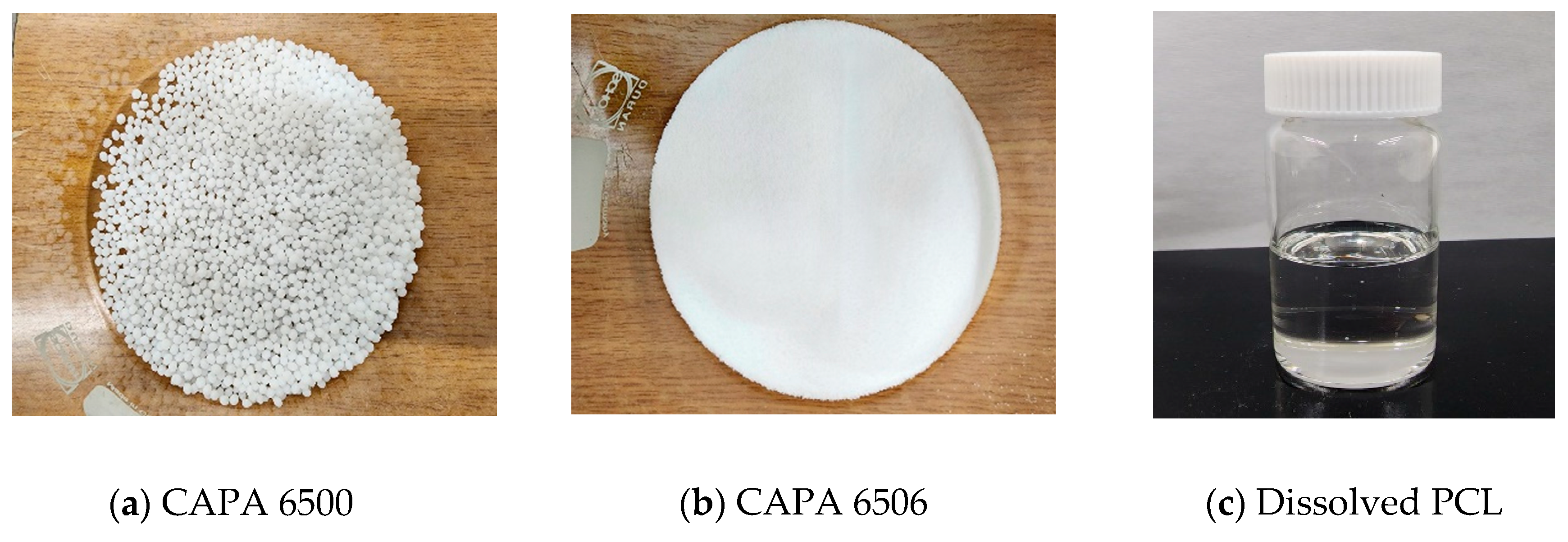
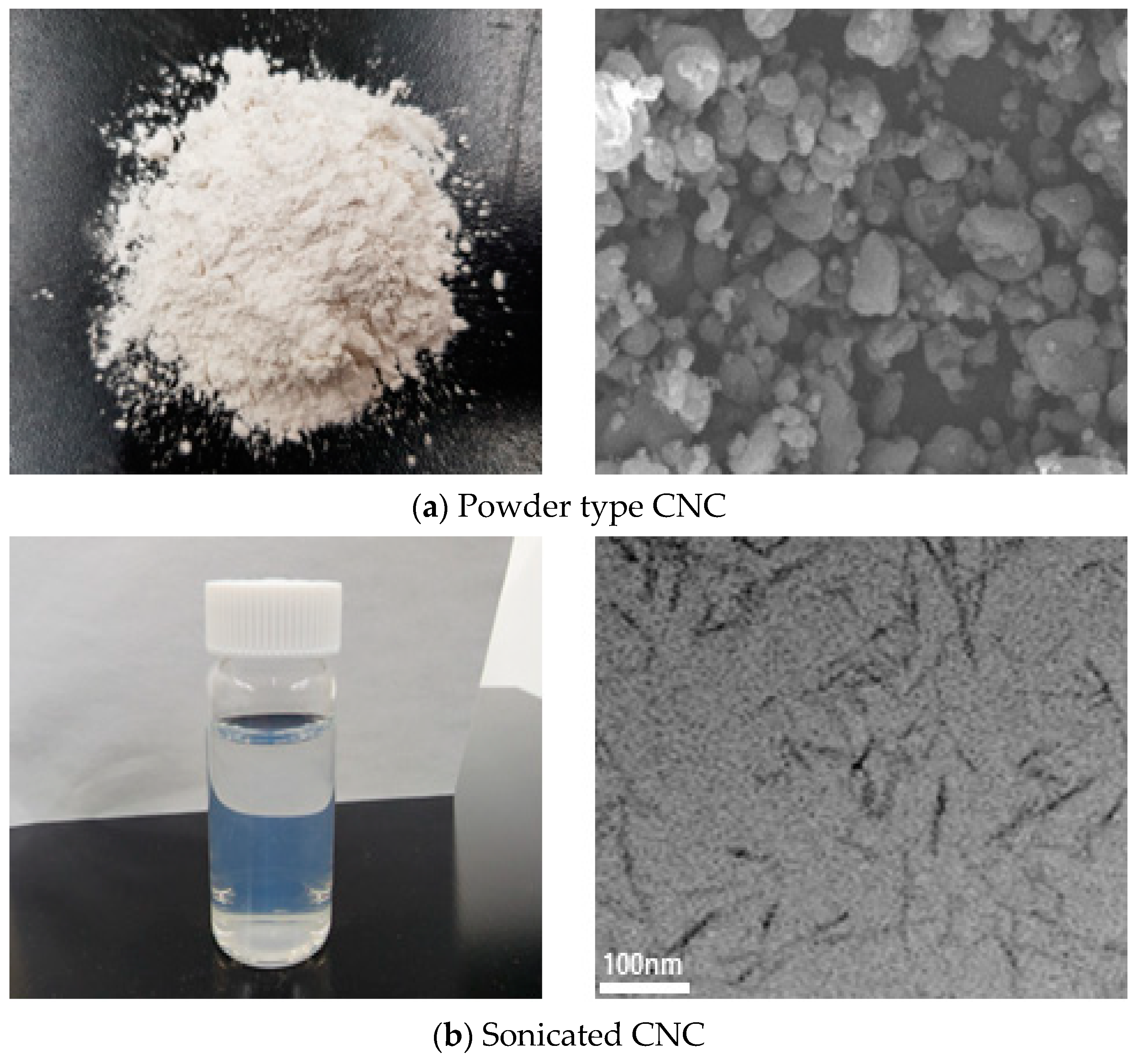
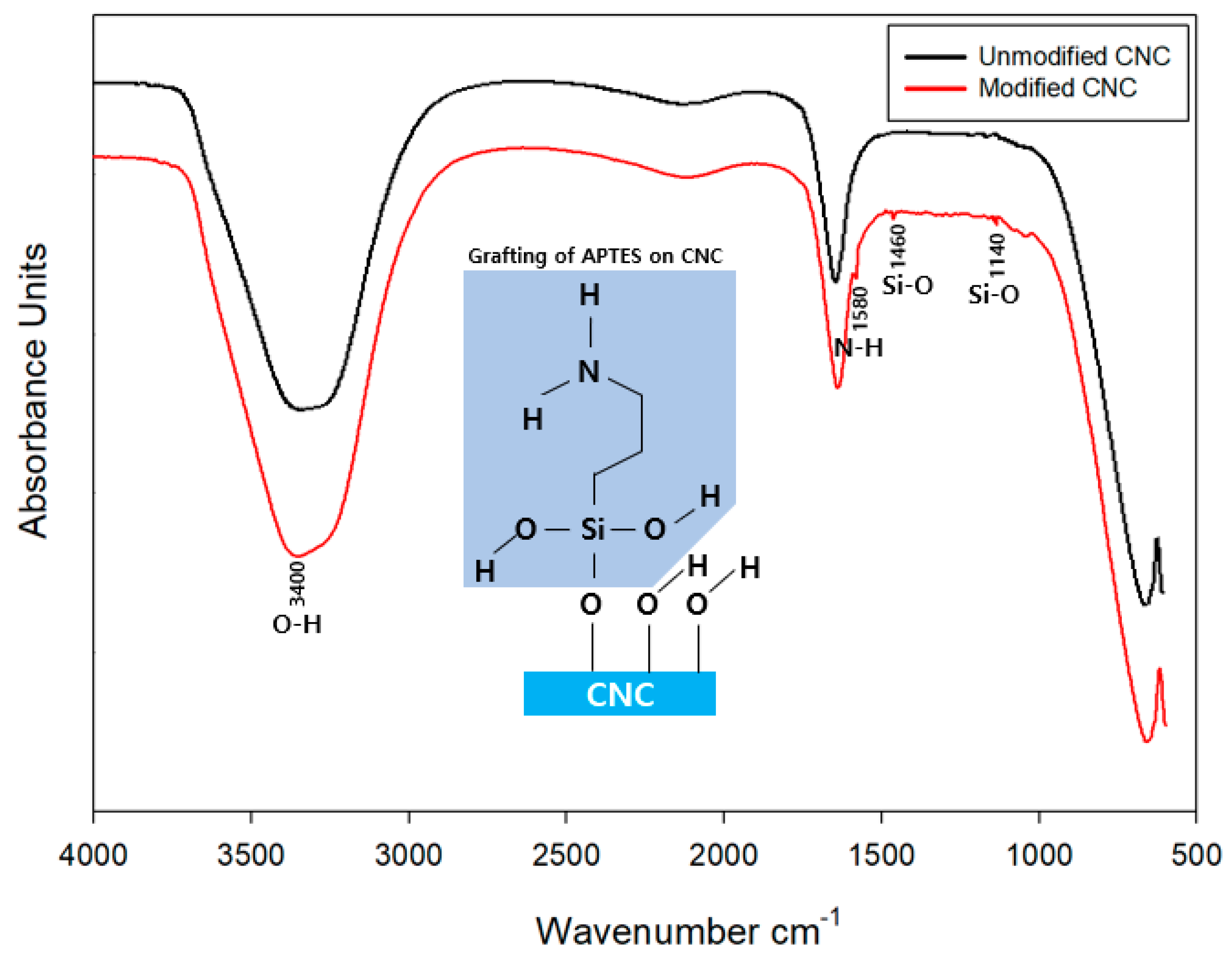

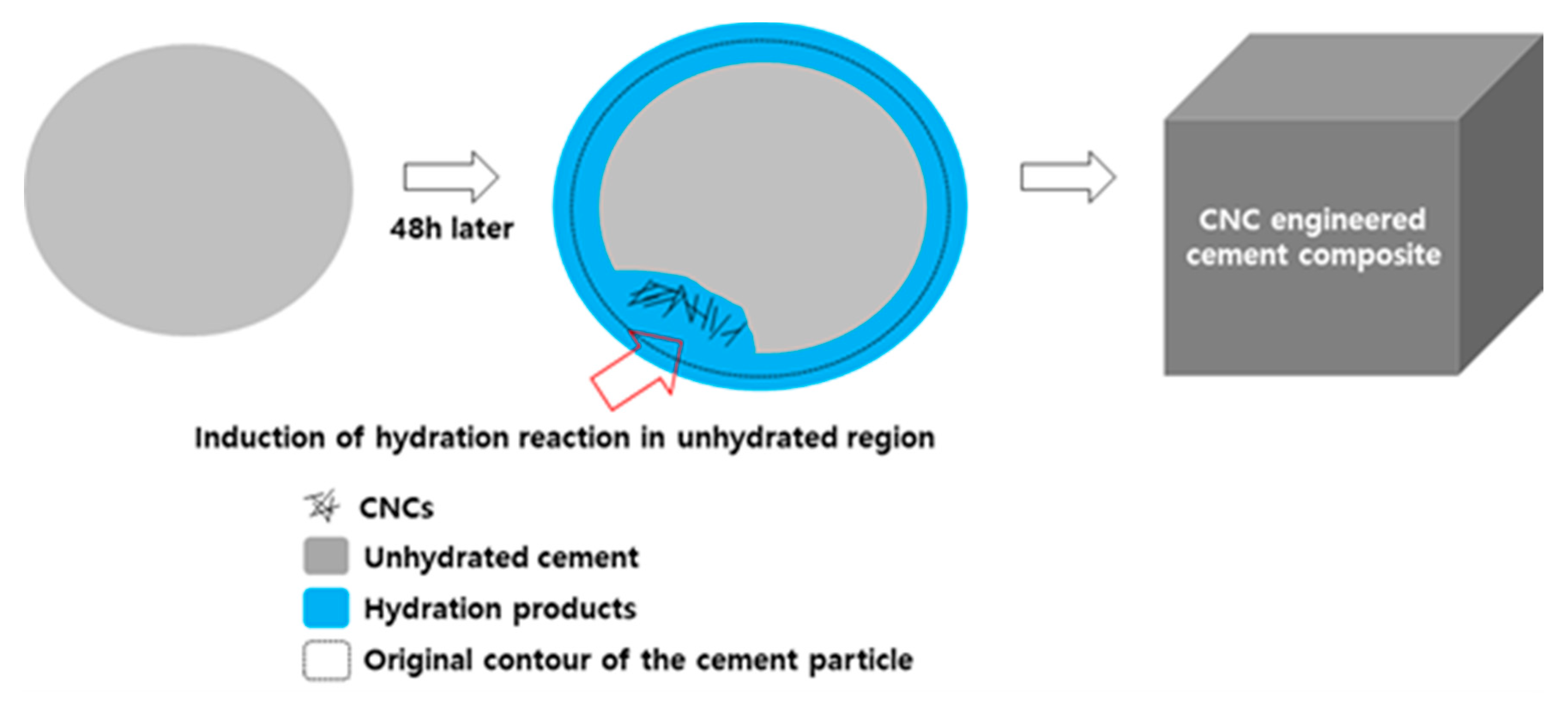
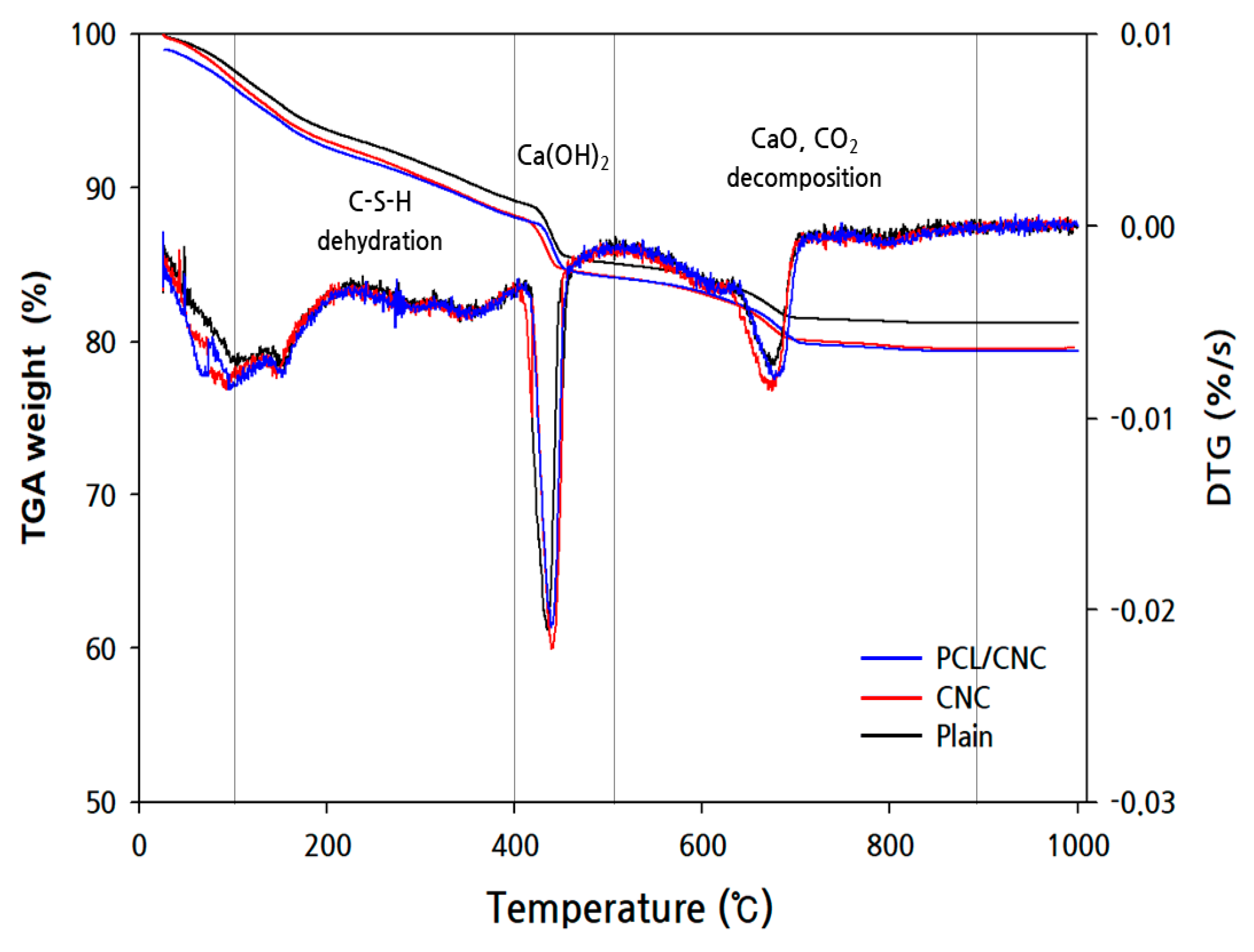


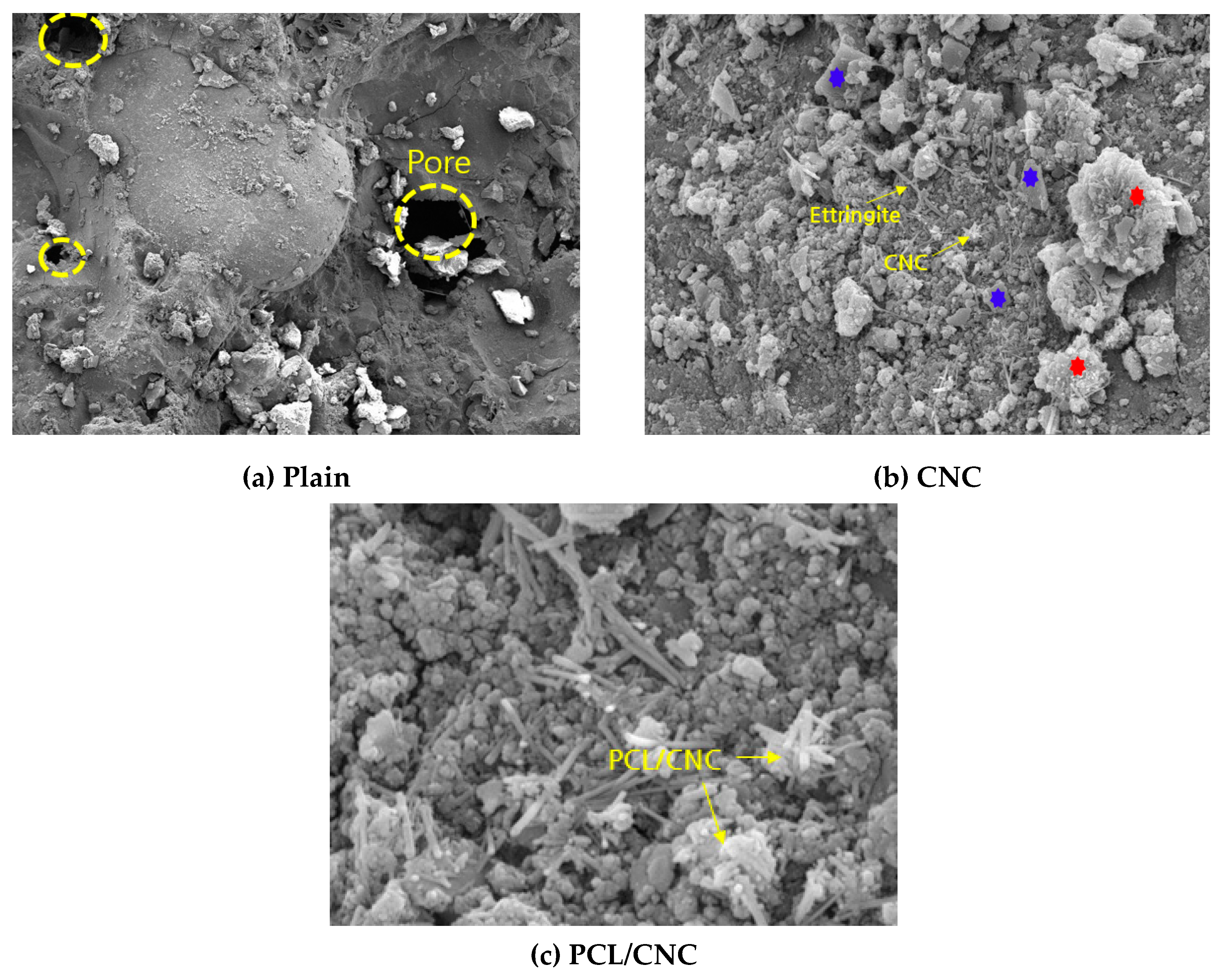
| Classification | Form | Molecular Weight | Color | Melting Point (℃) | Density (g/cm3) |
|---|---|---|---|---|---|
| CAPA 6500 | Granules | 50,000 | White | 58-60 | 1.1 |
| CAPA 6506 | Powder | 50,000 | White | 58-60 | 1.1 |
| Form | Color | Crystallite density | Particle diameter | Particle length | pH |
|---|---|---|---|---|---|
| Powder | White | 1.5 g/cm3 | 2.3-4.5 nm(by AFM) | 44-108 nm(by AFM) | 6-7 |
| Peak Position (cm-1) | Peak Assignment |
|---|---|
| 1000–1250 | Si-O stretching of Si-O-Si crosslinked |
| 1300–1400 | CH2 and CH3 scissoring |
| 1600–1670 | C=C-H axial deformation |
| 3200–3700 | Axial deformation of Si-OH group OH |
| Classification | Without PCL |
PCL Concentration (vol.%) | |||
|---|---|---|---|---|---|
| 0.1 | 0.3 | 0.5 | 1 | ||
| 7 days | 89–103 | 86–95 | 83–95 | 80–90 | 83–95 |
| 30 days | 68–97 | 68–88 | 68–88 | 69–90 | 63–72 |
| Zeta Potential, ζ (mV) | Stability Behavior of the Colloid |
|---|---|
| From 0 to ± 5 | Rapid coagulation or flocculation |
| From 10 to ± 30 | Incipient instability |
| From 30 to ± 40 | Moderate stability |
| From 40 to ± 60 | Good stability |
| More than ± 61 | Excellent stability |
| Tempering (°C) | Mass Loss (%) | ||
|---|---|---|---|
| Plain | CNC | PCL/CNC | |
| 105–400 () | 2.36 | 2.96 | 2.28 |
| 400–500 () | 0.81 | 1.24 | 0.72 |
| 500–900 () | 1.12 | 2.89 | 1.08 |
| 3.62 | 5.38 | 3.44 | |
| 17.01 | 20.67 | 16.01 | |
| Classification | W/C | C/S | CNC (vol.%) |
PCL | APTES (wt.%) |
S.P (vol.%) |
|
|---|---|---|---|---|---|---|---|
|
Granules (vol.%) |
Powder (wt.%) |
||||||
| Plain | 1:2 | 1:3 | - | - | - | - | - |
| CNC | 0.8 | - | - | - | 1 | ||
| C-P 1 | 1 | - | 3 | ||||
| C-P 5 | - | 5 | |||||
| C-P-10 | - | 10 | |||||
| C-P-15 | - | 15 | |||||
| Chemical Compositions (wt%) | |||||
|---|---|---|---|---|---|
| C | O | Al | Si | Ca | others |
| 26 | 52 | 1.9 | 2.2 | 14.6 | 3.3 |
Disclaimer/Publisher’s Note: The statements, opinions and data contained in all publications are solely those of the individual author(s) and contributor(s) and not of MDPI and/or the editor(s). MDPI and/or the editor(s) disclaim responsibility for any injury to people or property resulting from any ideas, methods, instructions or products referred to in the content. |
© 2023 by the authors. Licensee MDPI, Basel, Switzerland. This article is an open access article distributed under the terms and conditions of the Creative Commons Attribution (CC BY) license (http://creativecommons.org/licenses/by/4.0/).





